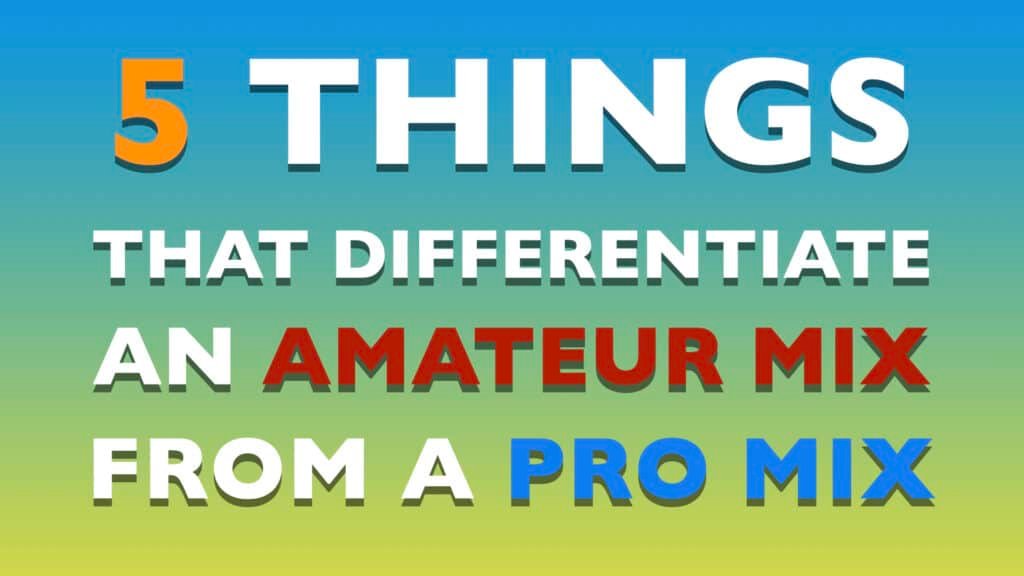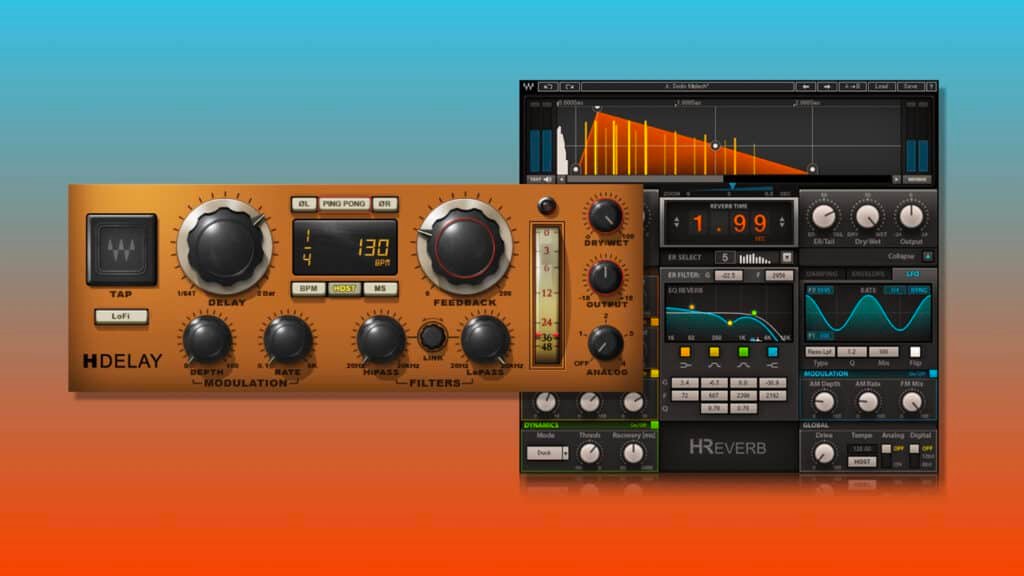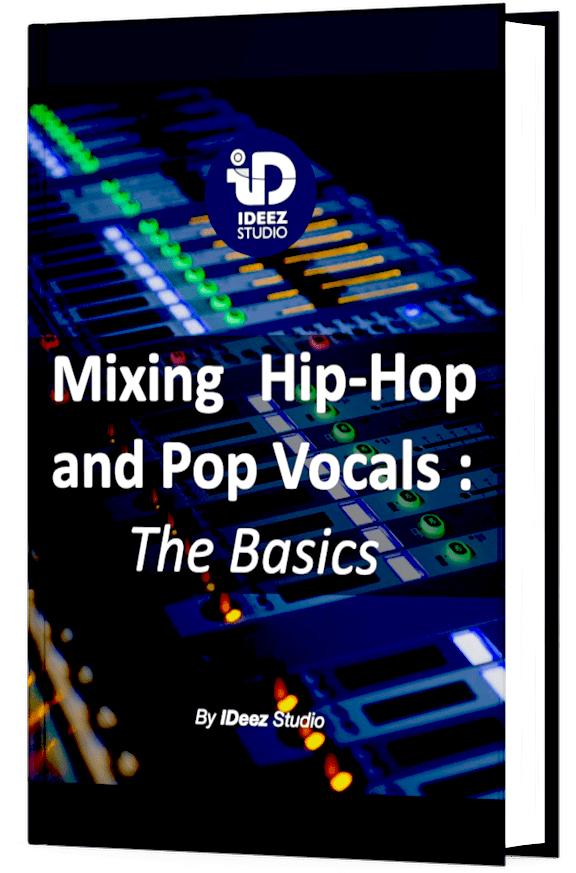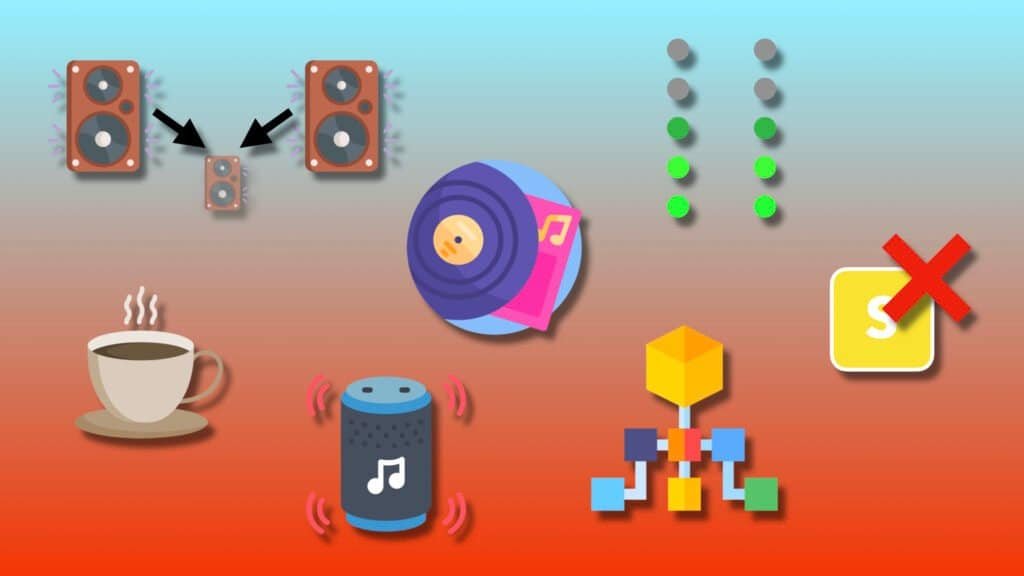At some point in your evolution in audio mixing, you might ask yourself what makes an amateur mix different from a pro mix. I’ve gone through this questioning myself, and understanding the answers has allowed me to take great strides forward.

The main elements that differentiate an amateur audio mix from a pro mix are the following :
- Recording quality
- Well-balanced frequency range
- Dynamic control
- Effects control
- Experience
We’ll see that some elements are easy to apply today in your audio mixes, but others will take much more time. There are no exact figures, it all depends on the investment and the passion you put into it.
If you’re ready, let’s go!
1. Recording quality
Okay, I know, this might turn some people off. You might think, “But… I don’t have enough money to compete with professional recording studios!” That’s totally legitimate.
But don’t worry, you don’t have to have a $6000 recording system to come close to the mix quality of your favorite songs. What you really need is the right way to record. In this article, for example, I give you 6 tips on how to record better vocals with your Rode NT1-A, one of the most widely used entry-level microphones in the home studio industry.
As mentioned above, recording quality doesn’t have to mean expensive equipment. Of course, I’m not going to lie to you, it does matter, otherwise recording studios wouldn’t exist. But when you have the skills, it’s only 25-30% of the final result.
This means that if you have the bare minimum in your recording setup (a good entry-level mic and preamp, an interface and a DAW of some kind), you have what you need in your hands to get close to pro quality.
Here are some tips to help you get on the right track :
- Take between 15 and 20 centimeters of distance from your microphone
- Don’t record too close to the walls and not right in the middle
- Pay attention to the gain of your interface to avoid saturation
- Don’t use a bad preamp

2. Well-balanced frequency range
When it comes to comparing an amateur mix with a pro mix, this is probably the area where the difference is most noticeable: the frequency balance.
When I talk about frequency balance, I’m not talking about the balance between all the elements of the mix (for example between kick and bass), but rather the frequency balance of each source. Let’s take the voice as an example, the most important element of all hip-hop and pop tracks.
In professional mixes, vocals are always clear, yet have warmth and presence. The vocals are natural and in total harmony with the rest of the instrumental.
In amateur mixes, a professional mix engineer, and often even a casual listener, will quickly feel that the vocals and the instrumental are two separate elements, which can potentially break up the song and cause the listener to move on to the next song quickly. The main reason is often because the vocals are not well equalized.
Let’s listen to two different audio clips. One of them is the rough mix. The other one is the final mix.
Comparing them, you can quickly hear that the rough mix (the first audio clip) stands out completely from the rest of the instrumental while the second is much more in harmony with it. The difference is largely in the EQ control.
In my opinion, well-equalized vocals are already 40% of a successful mix. But how do you get there? It takes time, patience and practice. Here are the steps I advise you to go through to get there :
- Take the time needed to learn what are the 6 frequency bands to focus on (click to read the article about this topic)
- Train your ears daily to differentiate each frequency band
- Try to link each frequency band to an emotion, an adjective (I swear, it works extremely well!)
- During your mixing process, take the time to compare your progress with pro references

3. Dynamic control
Dynamics control is also an element that can make the difference between an amateur and a pro mix. As a reminder, dynamics defines the difference in level between the highest and lowest levels. To illustrate this point, we will divide this term into two: micro and macro dynamics.
In our case, micro-dynamics refers to the difference in levels over a very short period of time (words, syllables,…). While macro-dynamics will refer to the differences over the whole song.
A. Micro-Dynamics
Not hearing certain words or syllables can be very unpleasant in a listening experience. But hearing a voice that is too powerful for the rest is also to be avoided. Dynamically, the job of the sound engineer is to make the listener hear every syllable of the singer/rapper while keeping a certain balance with the instrumental, which requires a relatively low dynamic.
In many amateur mixes, this macro-dynamic is not respected. Some words are too weak and therefore masked by the other sound elements, others are too loud.
To reach the professional standard at the micro-dynamic level, here are 2 tracks to explore :
Gain-Staging
In the context of audio mixing, gain staging consists of adapting the dynamics of an audio source manually to unify the level of this source.
This step is very important before any dynamic processing with a compressor. It will “pre-compress” and unify the dynamics of the audio source before attacking the compressor. Keep in mind that the compressor is not a magic tool, the source must be well processed beforehand to get the best results.
In the pictures below, the dynamic range of the audio clip (which was a voice), was much too big. So I turned down the most powerful syllables to even out the level.
Initial situation

Unified dynamics : Better situation

Compressor
The proper use of a compressor is essential for a good end result. But it is also an area that requires years of training to get the ears used to hearing and analyzing the micro-dynamics of a source.
Each source has to be treated differently, and giving you the compression standards for each of them would almost require writing a book. But if you want to start by mastering vocal mixing, I recommend my free e-book on how to mix pop and hip-hop vocals (on the right side of your screen and/or at the end of this page). You’ll learn the basics of vocal mixing in 20 minutes of reading!
B. Macro-Dynamics
Macro-dynamics represent the difference in level between the loudest and the quietest levels on a whole song. This means that the focus will no longer be on words, but on whole sections. Setting the scene…
Let’s imagine that, in a song, the bridge is extremely weak. No drums, just the singer and a melodic background. Instinctively, the singer/rapper will lower the level of his voice to adapt to the sound environment, which is totally normal.
If you don’t touch the general volume. The macro-dynamics of the song will drop drastically, which will be perceived as a hole by the listeners. Result: they will leave. This has to be avoided at all costs, because a good mix is a mix that holds the listeners until the end of the song.
The ultimate solution: Active mixing
Too many people think that mixing music is just a matter of putting the right plugins in the right tracks and letting the song roll to the end. This is not true!
What will make a mix go from amateur to pro will also be the mix engineer’s ability to follow every second of the song to make it exciting and hold the listener until the end. In the case of our bridge, the volume of the vocals, and perhaps the melodic accompaniment, should have been increased to keep as many listeners as possible.
Yes, it takes time, but I would say that it is 20-25% of the difference between an amateur and a pro mix.
Need a professional sound engineer specializing in pop and hip-hop mixing ? Great! Take a look at our services and let’s blow up your career together!
Let’s start now!
4. Effects control
Adding reverbs and delays is essential for a good music mix. But using them wrong can completely ruin your work in a second. And this is exactly where pro sound engineers win points: the effects are always under control, nothing is left to chance.
What many amateur mixers do, and I hear this very often, is to put a reverb in as an insert and adjust the mix knob without even worrying about the decay time, the type of reverb or any filters. This is a big mixing mistake.
Reverb does not necessarily mean long decay time. Sometimes shorter reverbs are better and don’t overload the mix.
Secondly, it is essential to use effects as auxiliaries, not as inserts. This allows you to have total control over the level of your effects and to make them live during the song.
If you want to learn more about the best ways to blend reverb and delay with rap vocals, click the link below, you will learn a lot about the topic.

By adding effects like reverbs and delays, your main goal should be to place your audio source in a certain universe and unify it with the rest of the elements with a certain subtlety. Finding the right balance is not easy and will probably take you a long time.
If you really don’t know how to use effects and don’t really want to read the above mentioned article, I suggest you focus on two things :
- Use all your effects on auxiliary tracks
- Try to adapt the decay time on the vibe and the universe you want to put your source in. Never leave the decay time knob as it is.
5. Experience
As an amateur, you might be disappointed to see that experience, which is a quality that is acquired over many years, is on this list. I can understand why.
Unfortunately, this is a fact. No skill is acquired in a few hours or days. It often takes years of hard work to get the skill you want to achieve. Music mixing is no exception.
It is said that it takes 10,000 hours of training to master a field. I don’t totally agree. Someone who has worked in a structured and organized way for 2000 hours will be much more successful than someone who has worked for 10,000 without any structure in mind.
But why is it that experience takes so long to gain when some tips seem so easy? The answer is simple : The more different situations you encounter, the more effective you will be in reacting accordingly. And after a while, some things will become automatic.
If you are passionate about mixing, it can be very frustrating to be aware that the learning process will take time. But learning daily is a completely underestimated motivation. I myself am still learning every day about my craft despite the years of experience, and I can swear that the best days are the ones when I learned the most about music mixing!
Conclusion
The differences between amateur and professional mixes are sometimes small, sometimes huge. But even the smallest things can be worked on daily. The most important thing is to stay focused on your goals and to continually compare your work to pro references. This allows you to clarify your ideas and to be able to analyze where you’re good and where you still need to improve.
Keep in mind that you’re never “bad” at anything, you just lack training and practice. Sometimes the sound quality of professional mixes seems unreachable, but by focusing on small things, step by step, you will surely reach one day, and maybe faster than you thought, an unexpected mix quality!
If you have any questions about that topic or about music mixing, contact me, I’m always very happy to help!






